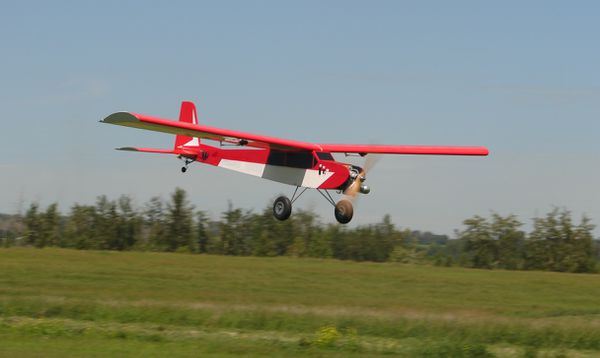UAlberta UASGroup
University of Alberta Unmanned Aircraft Systems Group
The University of Alberta UAS Group is a fledgling team composed of a number of research groups, students and professors at the University of Alberta in Edmonton, Alberta, Canada. The group is based out of the Department of Mechanical Engineering, with members from a variety of other departments, including Earth and Atmospheric Science and Electrical and Computer Engineering. We are currently preparing a small demonstration platform. This UAV platform will be the beginning of an attempt to foster UAS research at our university, and provide an initial starting point for researchers from a variety of disciplines and departments to begin research on unmanned aircraft systems directly (like controls), or, more likely, to investigate payloads and applications (like industrial monitoring).
Current Work
The first platform is Unmanned Aircraft Platform 1, or UAP1.
UAP1
Airframe:
- Type of aircraft: Hobby Lobby Senior Telemaster almost-ready-to-fly model aircraft
- Modified for bolt-on wing and tail-mounted servos
- Type of engine: 2-stroke 26cc Evolution 26GX with electronic ignition (2S 2500mAh Lipo)
- Dimensions: wing span 2.4 m (94 inches); fuselage 1.6m (64 inches)
- Actuators: Hitec programmable digital servos used throughout
Autopilot Systems:
- Spektrum DX8 system with AR8000 receiver and TM1000 telemetry module for safety pilot situational awareness
- 2S 4000mAh Lipo for servos and autopilot system
- Paparazzi autopilot
- TWOG v1.0
- Ublox LEA5H and Sarantel helical antenna
- Aspirin IMU via I2C
- Eagle Tree airspeed sensor
- ATMega168 based PPM encoder
- SmartFly optical ignition cut-off
- Digi XTend 900MHz radio modems
- Ground Segment:
- Macbook Pro with OS X 10.6 (running Paparazzi in OS X)
Payload Systems:
- Currently not determined, though initially a GoPro will be mounted onboard
Flight Progress
Currently, we have successfully flown UAP1 in manual and auto1. It took a long time to modify the model, install the autopilot systems and deal with vibration issues from the gas engine.
Vibration (WORK IN PROGRESS)
Vibration can be a major problem in small UAVs (fixedwing and rotorcraft alike). Vibration can come from a variety of sources, but in UAVs the most significant source is rotating machinery, i.e. the primary powerplants in the airframe.
Major Sources of Vibration:
- Main electric motors
- Internal combustion (IC) engines
- Unbalanced propellers
Minor Sources of Vibration:
- Flutter or resonance in flight surfaces and airframe
- Actuators or servos for flight or payload control
In general, the main source of thrust will be the primary source of vibration. Electric motors generally do not introduce strong vibrations into the airframe, though an unbalanced propeller on an electric motor can be very noticeable. On the other hand, IC engines, whether glow or spark ignition, usually introduce extreme amounts of vibration into an airframe.
A brief introduction to vibration can be found on Wikipedia here.
- how to calculate natural frequencies etc, perhaps some modeling discussion?
Implications of Vibration
Vibration can have many detrimental effects on UAV airframes. Some examples are:
- airframe fatigue
- can affect glue joints or high stress locations
- reduces lifetime of servo actuators
- touching components can wear away at one another
- fuel line or motor cable on sharp edge of bulkhead
- foaming fuel
- wiring fatigue (including RF connections)
- wire strands on sharp connector or crimp edges
- connectors rated for limited insertions, removals, as well as vibration
- switches can degrade, fail, switch in flight
- look for MIL spec parts with high vibration ratings
- lower flight and powerplant efficiency
- increased sensor noise and bias
- gyros, accelerometers, magnetometers, pressure transducers, etc
- potential for sensor saturation
- in particular, gyros and accelerometers in IMU
- degradation of payload sensor data quality
- especially imagery with CMOS sensors, increase in rolling shutter effects, motion blur, shaky video
One of the most noticeable problems with high vibrations is in attitude estimation. MEMS gyros and accelerometers can be very sensitive to vibration, and the filtering algorithm can not always fix the problem. The vibration can sometimes cause significant drift or divergence of the filtering algorithm, making the attitude estimation useless.
Mitigating Effects of Vibration
There are a number of strategies for mitigating vibration effects in the airframe. Often a combination is required.
- mechanical methods, best, helps all parts of airframe
- calculating and testing
- recommended methods and materials
- things to keep an eye out for (resonance on parts)
- software filtering for IMU and other sensors, advantages and disadvantages, explain addition to fw aspirin i2c driver, video shake reduction
- show some samples from vibration testing
- pictures/sketches of mounting methods
- discussion on how to identify vibration problems
- discussion of sensor noise effects, namely on DCM algorithm, give examples with aspirin IMU, add screenshots of logs

